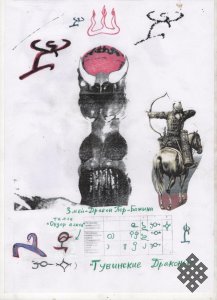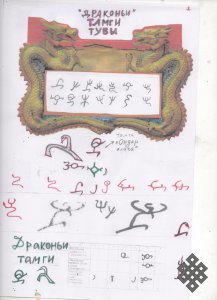"Celestial Dragon, with breath of fire.
Our own, three-headed, of three natures…"
(Kolokhan-bagshi)
 This Year of the Dragon has, de facto, started off in Tuva somewhat earlier before its usual calendar term, announcing its coming with an earthquake, which, as a matter of fact, did not cause serious injuries to the population; that is fully understandable, because ancient Uriangkhai can be considered the homeland of dragons. Professional astrologists warned that unpredictability, unexpectedness, and spontaneity of events are quite characteristic of this calendar-mythological personage, and mentioned his habit of showing up before the usual term, suddenly changing all the established rules and norms.
This Year of the Dragon has, de facto, started off in Tuva somewhat earlier before its usual calendar term, announcing its coming with an earthquake, which, as a matter of fact, did not cause serious injuries to the population; that is fully understandable, because ancient Uriangkhai can be considered the homeland of dragons. Professional astrologists warned that unpredictability, unexpectedness, and spontaneity of events are quite characteristic of this calendar-mythological personage, and mentioned his habit of showing up before the usual term, suddenly changing all the established rules and norms.
There are many misconceptions in western astrology and mythology about the coming Year of the Dragon and its totemic protector spirit, Fire-Breathing Serpent-Dragon, which are very offensive to this totally noble, valiant and wise personage of Central Asian nomad folklore.
The dragon-fighting motives characteristic of Western European civilization determined the dragon-phobic themes in oral folk art, transferred to artistic literature, where, for example, this is a popular subject line: brave and noble hero - knight kills the evil, sneaky, bloodthirsty Dragon and rescues the beautiful princess…
Chinese civilization, in problems of dragonology , adheres to a diametrically opposite point of view, which also influenced Eastern Asian calendar, where, just like in our Central Asian, Tibetan-Mongolian calendar, Dragon is a lawful personage of the 12-year cycle, of which the great 60-year cycle is composed. More that that, here Dragon is a symbol of time itself, the paradoxical dialectics of its segmentalization (i.e. presence of discrete stable units) and continuity, fluidity, timelessness, impermanence and changeability.
The Dragon's fiery nature gave him such qualities as dynamic nature, huge energy, swiftness and impetuosity of action, creative power, force and imagination, and that is the reason why Dragon is the symbol of the First hexagram of Chinese "Book of Changes", named "The Creative" (I Ching - "Book of Changes" is a fundamental philosophical work, which at the same time is also a major book of divination. For that reason its other name is "Book of Divination"; it consists of 64 hexagrams used by Chinese astrologers to derive a diagnosis and prognosis of development of life situations).
However, this Fire-breathing Dragon can, if necessary, be extremely cautious, careful, slow and immobile, and can even periodically fall into a state of hibernation, sequestering himself in his water cave in deep sleep, just like a bear in its den. It is also the most universal sign in Chinese astrology, which summarizes the qualities of all other signs in its own nature, each of which is somewhat limited in its characteristics; the Dragon is versatile to such degree that it can turn into any other creature, from the largest to the tiniest and most insignificant. The Dragon is considered the most mystical image in Chinese mythology, with tendencies to changing into something else, that some even believe that he does not exist in reality, because nobody has ever seen one, and artists drew him only from ancient descriptions.
Most likely, first, the image was drawn from completely real prototypes, the remains of which are still found in great numbers in the deserts of Central Asia, and second, in the traditional culture of nomads, who have always been neighbors of agricultural nations of East Asia, the image of serpent-Dragon was well known and frequently depicted on flags as a symbol of their totemic ancestors and protectors. In any case, in traditional China there were strict norms of depiction of this personage, which is evidence of some real underlying model: "The Dragon should have bulging eyes, moustache, fangs, wide-open nostrils, and it should also have scales and claws", it should have "slim, flexible torso, four paws, and feathered tail" (Natalie Lo Yan "Orakul", 2011, No.12, pg.3).
The tendency to changeability, which is only the other side of his universalism and magic power, makes the Chinese dragon a relative of our own familiar celestial Serpent-Dragon of Turko-Mongol mythology, which undoubtedly, also became the archetypical ur-model of the astrological sign of Dragon in our Buddhist Tibetan-Mongolian calendar. As we have noted above, the most ancient calendar system of Eurasia was invented by our ancestors the Uighurs already at the dawn of nomadic civilization, when they lived in Siberia , in Sumeru mountains, where the ancestors of Sumerians also lived; they are believed to be the inventors of the 12-year calendar cycle (Abayev, Ayunov, 2010). The ancient Uighur 12-year calendar, which was transmitted to all Turko-Mongol peoples, was based on "animal" totems including the Year of the Dragon, and was called "Mushel" (Ayunov, 2005).
 At the same time, our Central Asian, Turko-Mongol Dragon, which became the archetypal image in entire Eurasian my6thology and folklore ( se Three-Headed Serpent Gorynych in Slavic mythology, which is very obviously related to Tugarin son of Serpent of western Turks), is even more universal that the one-headed Chinese Dragon, and may have three or even sixty heads (see Tuvan "aldyn bashtyg Amyrga Chylan" - sixty-headed Serpent Queen"), or as many heads as is convenient. He has many names as well - Azhy-Dazhaka, Amyrga-Moos, Avarga-Moge, Azhyrai-Bukhe, Kara-Moos, and others.
At the same time, our Central Asian, Turko-Mongol Dragon, which became the archetypal image in entire Eurasian my6thology and folklore ( se Three-Headed Serpent Gorynych in Slavic mythology, which is very obviously related to Tugarin son of Serpent of western Turks), is even more universal that the one-headed Chinese Dragon, and may have three or even sixty heads (see Tuvan "aldyn bashtyg Amyrga Chylan" - sixty-headed Serpent Queen"), or as many heads as is convenient. He has many names as well - Azhy-Dazhaka, Amyrga-Moos, Avarga-Moge, Azhyrai-Bukhe, Kara-Moos, and others.
But the most popular in Central Asia and Sayan-Altai, including with Tuvan Uighur-Uriankhs, was, after all, the Three-Headed Fire-Breathing Celestial Serpent-Dragon, combining paradoxically the functions of Ruler of Water Depths (element water), the Lower World, and the Middle World -(world of people).
As a whole, he symbolized the unity of the world, the Universe, and the tripartite structure of the world, as evidenced by the three heads on one torso, which also symbolized the unity of all living creatures, and was pictured with a fish (dragon) tail, bear paws, wolf's neck and shoulders, etc. On some medieval images, the Fire Dragon was even associated with Tengri-Khan himself - the Supreme Heavenly ruler of the entire Tengrian pantheon. Precisely such a statue was found several years ago by "Celestial" shamans of Tuvan "Dungur" association, headed by K. T. Topchun-ool not far from the famous Uighur fortress Por-Bazhyn; its totemic deity-protector was the Fire serpent Dragon, which was considered at the same time a warrior deity (see: table No.1 "Serpent-Dragon of Por-Bazhyn").
It was a generalized image of all the totemic deities-protectors of various tribes and clans of Turks, Uighurs, Mongols and Uriangkhai (wolf, bear, mountain goat and others), that is why it embodied the qualities of all these totems, at the same time uniting them in a single symbol of supreme rule, power and aggregate energy of common centralized state, created out of unions and confederations of separate tribal-clan groups. Just like the Chinese dragon was a symbol of the rule of the empire and a single state. Together with this, being the key element of clan tamgas, (Tuvan - tanma) and other symbols of a concrete ethnos (symbols, heraldic signs, etc.), the Dragon also signified individual representatives of this or that tribe or clan. That is why "dragon tamgas" seen in petroglyphs of Tuva as well as on walls with runic inscriptions, mean not just the ethnicity of Tuvan population but they also serve as original markers of ethic territory, its cultural-historical landscape, and evidence of the heroic past of its people.
As far as the symbolism of the calendar and the psychological images embodied in it, philosopher and astrologist Oleg Borovik answered quite correctly: "The main talisman of the coming year is the living Dragon. Not some mythical reptile, but a person born in the Year of the Dragon. If you want to attract success, preserve your friendship with representatives of the Dragon breed!" at the same time the astrologist warns us: "our current ruler is the Black Water Dragon. And that is where the conflict lies, because the Dragon's element is the fire! And since the energetics of the patron of this year is combined from two opposing elements, do not expect a quiet life: now an acute, explosive changes, now periods of icy paralysis and stagnation…" )"Orakul" 2012, Non.1, pg6.)
As a whole, the contemporary astrology ascribes people-dragons with positive psychophysiological, moral-psychological and bioenergetic traits: inner nobility, passion, but also goal-orientedness, sense of justice, magnanimity, some degree of individualism compensated by enterprise, initiative and creative approach to action; the Dragon is also demanding, both of himself and of other people. In connection with this O. Borovik warns that one always has to keep in mind: "Dragons are special people, they give a lot, but they demand a lot too" (Orakul", as noted). These and other traits are documented, for example, in the biographies of famous Dragons: A. Blok, E. Kant, J.R. Tolkien, M. Gorky, A.Fet, A. Grin, T. V. Wilson, J. Marshall, E. Swedenborg, A. Nevskiy, N. Nazarbayev, V. Putin, Ch. Aitmatov, O. Schlengler, N. Ostrovskiy, and others.
In this way, even though this Year of the Dragon started in Tuva with underground tremors, and also somewhat before the schedule established by Chinese calendar, we can feel free to plan various far-reaching initiatives leading to cardinal changes; one just has to be brave, swift and accurate, at the same time remaining cool and sensible, caution and ability to adapt with alacrity to quickly changing circumstances. People of Tuva should especially keep in mind that their native totem will not let them be harmed, and as the saying goes: "Tengri won't give you up, Dragon won't devour you!"

